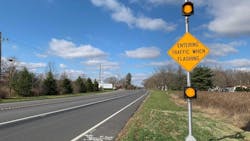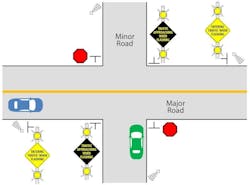Improving Safety with Intersection Conflict Warning Systems
Intersection Conflict Warning Systems (ICWS) are improving traffic safety across Indiana by reducing the likelihood of severe vehicle crashes at some non-signalized, two-way stop-sign controlled intersections.
ICWS is a traffic safety measure proven effective in other states under certain traffic and road conditions. The Indiana Department of Transportation (INDOT) has installed 17 of the systems at highway intersections since summer 2020.
ICWS provides an added alert to drivers approaching on the high-speed mainline or stop-controlled crossroad to raise awareness of approaching traffic. According to the Federal Highway Administration, ICWS can reduce severe crashes at intersections by 20% to 30%.
“Our central office and districts initially started looking into how to improve safety at stop-controlled rural intersections that had an unacceptable history of notably right-angle and rear-end crashes and largely where less-intense corrective actions didn’t produce suitable results,” said Prakash Patel, manager of Traffic Design at INDOT. “We identified 35 of these intersections in Indiana and ended up selecting 17 for this initial treatment.”
Of the 35 initial locations selected, one location was dropped during planning because of intersection traffic volumes. Of the first 17 projects completed, 14 locations are at intersections where a two-lane highway crosses another two-lane highway, and three are at intersections where a four-lane divided highway crosses a two-lane highway. The remaining 17 locations are candidates for this treatment in the future.
Stop-controlled intersections consist of a major road intersecting a minor road. The major road typically carries higher traffic volumes at a high-operating speed, and the driver approaching the intersection is not faced with a stop sign but may see advance warning signs. In comparison, the minor road usually carries lower traffic volumes, and the approach is controlled by a stop sign. Crashes at these intersections continue to represent a significant share of motor vehicle fatalities and injuries.
ICWS is not intended to assist drivers in selecting suitable gaps in approaching traffic; rather, the intent is to assist drivers with rejecting unsuitable gaps. The selection of unsuitable gaps has been shown to be a contributing factor to crashes at intersections where the traffic on the major road is uncontrolled while traffic on the minor road is controlled by a stop sign.
“The majority of the sites selected for this treatment have less than optimal sight distance. In areas with rolling or curvy terrain, these systems will provide supplemental information for drivers to make safer decisions,” said INDOT District Traffic Engineer Damon Brown. “Vehicles on the major road will be more aware of an approaching intersection, and vehicles at the stop signs will have affirmation that a vehicle may be about to pop over the crest of a hill and not to pull out into traffic yet.”
The ICWS uses under-pavement vehicle detectors, fixed and variable sign messages, and flashing lights to notify drivers on both roads of approaching or waiting vehicles. The system includes signs and flashing amber warning lights that provide drivers with a real-time warning of vehicles either approaching the intersection on the major road or waiting at the stop sign to enter the intersection from the minor road.
In Indiana, drivers on the major road see a static ENTERING TRAFFIC WHEN FLASHING sign and flashing amber warning lights when a vehicle is waiting on the intersecting minor road. Drivers on the minor road, in addition to a stop sign, see a constantly illuminated blankout sign message TRAFFIC APPROACHING WHEN FLASHING and an amber flashing light when a vehicle is detected approaching the intersection on the major road. The blankout sign message on the minor road always remains on, even when no vehicle is detected on the major road coming into the intersection.
In the case of a power outage, the blankout sign will be black/off, but the regulatory stop sign will always be present on the minor road.
The moderate- to low-volume intersections selected for the ICWS by INDOT feature major roads with daily traffic (AADT) of less than 12,000 and minor roads with AADT of less than 3,000.
Vehicle detection is generated from inductive loops in the pavement. On the major road, two loops set 20 ft apart detect the speed of the vehicle; they are set at nine seconds travel time to the center of the intersection. On the intersecting minor road, two loops are set 9 ft apart near the stop bars for the intersection.
Costing at or under $100,000 per site each to install, ICWS is a mid-range intervention. ICWS is generally installed after lower-cost treatments, such as adding or up-sizing traffic signs and pavement markings, fail to produce positive results and before more intense and expensive improvements, such as outright intersection reconstruction, are attempted.
Intersection crashes occur for multiple and complex reasons, including factors associated with driver behavior, condition and features of the vehicle, and road and site characteristics. Under fitting traffic and site conditions, treatment of an intersection with ICWS will not eliminate risk of all crashes but will reduce the frequency of select types. Drivers should still exercise caution when approaching or entering intersections, even when lights are not flashing.
INDOT will perform a before-after in-service performance analysis over the next several years to quantify the effect on crash frequency and severity at ICWS stop-controlled intersections. Based on prior research, INDOT expects to see a reduction in severe crashes by one-quarter to one-third (higher or lower depending on the individual pattern and severity). There is optimism that Indiana’s unique ICWS features and application methods will produce even more favorable outcomes.
“INDOT is going to be studying these for the next several years to determine what their final impact is and whether they’re performing as we intended,” Patel said. “The AADT level of the mainline highway is considered one key to the effectiveness of this treatment, so we’ll be closely following crash performance at all sites to see how ICWS effectiveness may vary across that and other conditions present.”
This was INDOT’s first experience in taking this novel safety treatment from planning to operation, and with that came the need to systematically work through all the necessary tasks associated with a new feature, such as drafting design standards and operating policies. INDOT’s ICWS program involved the input and support of multiple agency departments, including the executive staff, Traffic Administration, Traffic Safety, Traffic Management, Technical Services, Right-of-Way, Legal, and Communications. The Federal Highway Administration, both in Indiana and Washington D.C., and the Minnesota Department of Transportation also assisted in the development and rollout of INDOT’s system.
“Installations of all our ICWS were made under a single, bundled contract, which stretched across the state,” said Project Manager Troy Arnold. “Pulling together that contract and managing contractor activities were challenging, but INDOT has deep experience in bundling contracts and managing similar, combined projects. We were able to draw on that knowledge base to successfully combine and manage the ICWS installations.”


